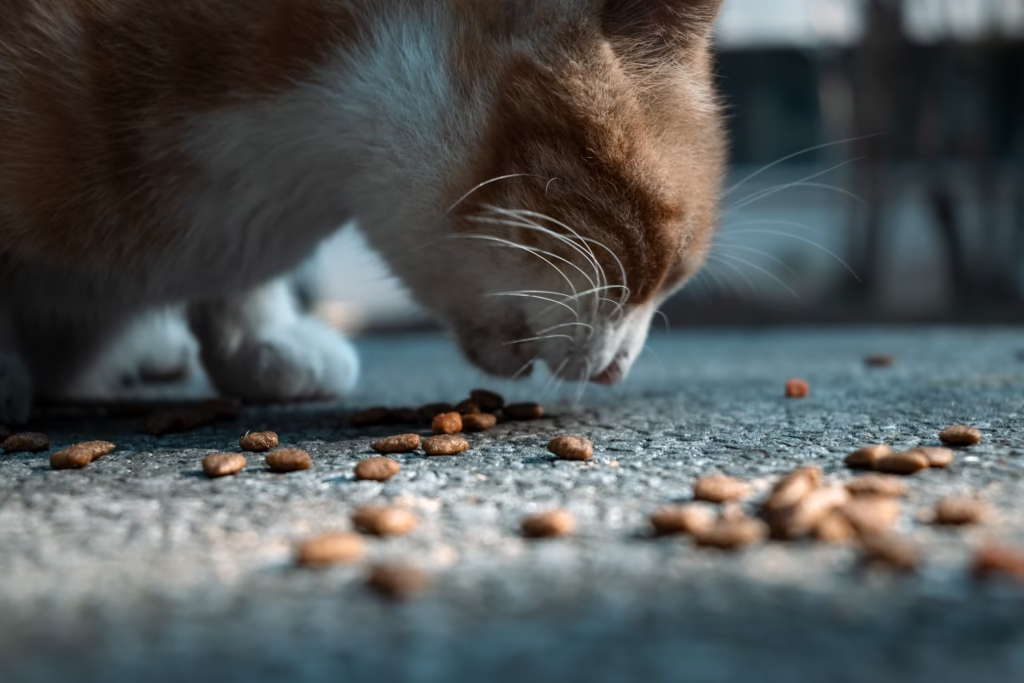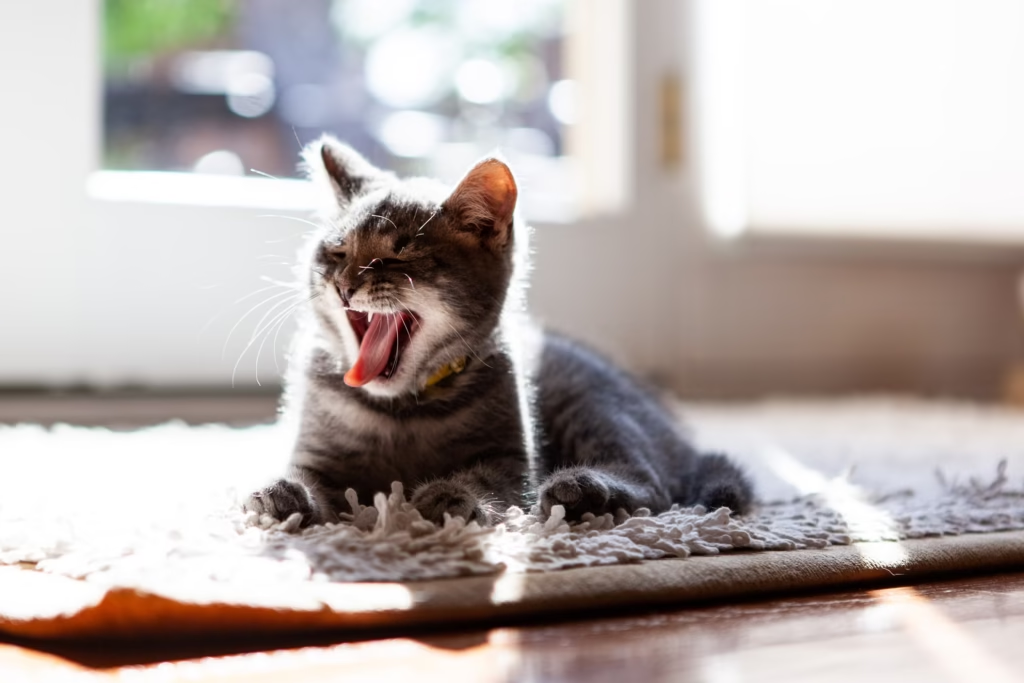Why Is My Cat Throwing Up Undigested Food? 🤮 Vet-Approved Causes & 7 Real Fixes That Work!

You’re sipping coffee, starting your day, when you hear it—that unmistakable retching sound. You rush over and find your cat has just thrown up what looks like whole kibble, again. Sound familiar?
If you’ve ever typed “why is my cat throwing up undigested food” into Google at 6 a.m., you’re not alone. And while occasional vomiting in cats isn’t always a crisis, frequent regurgitation—especially of food that looks barely touched—can be a red flag.
In this in-depth guide, we’ll help you figure out exactly what’s going on, why your cat might be throwing up food or even bile, and, most importantly, what to do when your cat throws up. From medical to behavioral causes, and seven vet-backed solutions, we’ve got you (and your carpet) covered.
Table of Contents
Is It Vomiting or Regurgitation? Know the Difference First
Before diving into causes, let’s clear something up: there’s a difference between vomiting and regurgitation.
- Vomiting is an active process—it’s noisy, often involves retching, and the expelled food is usually partially digested.
- Regurgitation is passive—it happens quickly and often with whole, undigested food, usually right after eating.
Either way, if it’s happening often, there’s a problem worth investigating.
Why Is My Cat Throwing Up Undigested Food? 😿 7 Common Causes According to Vets

1. Eating Too Fast 🍽️
Let’s be honest—some cats eat like they haven’t seen food in days. Fast eating can cause food to expand too quickly in the stomach, leading to regurgitation soon after meals.
🧠 Vet Insight: “Many cats who throw up undigested food but act normal afterward are just eating way too fast,” says Dr. Emily Carter, DVM. “Their body can’t handle the sudden influx.”
Signs to watch for:
- Vomiting occurs within 15–30 minutes after eating
- Food appears whole or barely chewed
- Your cat seems totally fine afterward
2. Poor Diet or Sudden Food Changes 🥩
Low-quality cat food packed with fillers, artificial dyes, or mystery meats can be hard on your cat’s stomach. So can switching food brands too quickly.
🤔 Did you know? Cats have super sensitive digestive systems. Introducing new food abruptly can lead to vomiting or even a cat throwing up bile if the stomach stays empty too long between meals.
Common triggers:
- Grains or artificial preservatives
- Dairy (many cats are lactose intolerant)
- Rapid food changes without a gradual transition
3. Hairballs (More Than You Think!) 🐾
If your cat is throwing up undigested food AND coughing up a wad of fur, hairballs are likely the culprit. Long-haired cats and obsessive groomers are especially prone to this.
🧶 Fun fact: Cats spend 30–50% of their awake time grooming. That’s a lot of fur going down the hatch!
4. Gastrointestinal Issues 🩺

Conditions like inflammatory bowel disease (IBD), gastritis, or pancreatitis can irritate your cat’s digestive tract. If your cat is throwing up undigested food but also losing weight or acting lethargic, don’t wait.
🚨 Vet Alert: “Chronic vomiting isn’t something to brush off. GI diseases are treatable but need proper diagnosis,” says Dr. Carter.
Watch out for:
- Diarrhea
- Weight loss
- Blood in vomit
- Frequent or daily vomiting
5. Parasites or Infections 🦠
Roundworms, hookworms, or even bacterial infections can wreak havoc on your cat’s stomach. This is especially common in kittens or cats that go outdoors.
🔬 Reminder: Indoor cats aren’t immune. Fleas can carry tapeworms!
6. Stress or Anxiety 😾
Cats don’t do well with change. New pets, loud environments, or even rearranged furniture can lead to upset stomachs and vomiting—yes, really.
😼 Expert Note: “Cats that seem ‘normal’ but throw up food regularly may be responding to environmental stress,” says Dr. Carter.
7. Serious Underlying Illnesses 🚑
While less common, intestinal blockages, liver disease, or even cancer can cause vomiting. Especially if your cat is throwing up bile, appears lethargic, or stops eating.
🚨 Don’t ignore:
- Yellow/green (bile) vomit
- Blood in vomit
- Sudden behavior changes
What to Do When Your Cat Throws Up: 7 Vet-Approved Fixes ✅

Whether it’s the occasional pile of food or something more chronic, here are the best steps to stop the mess—and get your cat feeling better.
✅ Fix #1: Visit the Vet (Seriously, Don’t Skip This) 🩺
Start by ruling out serious medical issues. A vet can perform:
- Bloodwork
- X-rays
- Ultrasound
- Fecal tests (for parasites)
💡 Pro Tip: Bring a photo or even a small sample of the vomit—it helps more than you think!
✅ Fix #2: Slow Their Eating Habits 🍽️
If your cat is inhaling food, try:
- Slow feeders with ridges or mazes
- Puzzle feeders to make mealtime more engaging
- Spreading kibble on a tray or cookie sheet
- Feeding smaller meals throughout the day
🐱 Tip for Multi-Cat Homes: Feed cats separately to reduce competition.
✅ Fix #3: Upgrade Their Diet 🥩
Food matters—a lot. Here’s how to improve digestion:
- Choose premium brands with real protein and minimal fillers
- Try wet food to improve hydration and reduce stomach irritation
- Gradually introduce new food over 7–10 days
- Avoid treats or table scraps
🌟 Bonus: Wet food can prevent bile build-up during long fasting periods.
✅ Fix #4: Tackle Hairballs Head-On 🧼
Reduce the fur going in, and the vomiting coming out:
- Brush regularly—daily for long-haired cats
- Try hairball control food with extra fiber
- Use hairball gels (ask your vet for a recommendation)
- Encourage hydration with a water fountain
✅ Fix #5: Minimize Stress at Home 😽
For anxious cats who vomit undigested food but seem fine otherwise:
- Set up safe zones (like cozy beds or cat trees)
- Use calming pheromone diffusers (e.g. Feliway)
- Stick to a consistent routine
- Play with them daily—interactive toys can reduce tension
🎯 Pro Tip: Even small changes (like moving a litter box) can stress a cat out.
✅ Fix #6: Deworm and Stay on Top of Parasite Prevention 🧬
Don’t skip deworming!
- Get annual fecal exams
- Use vet-recommended dewormers
- Keep up with flea treatments (fleas = tapeworm risk)
- Keep shoes and bags that have been outside away from food/litter areas
✅ Fix #7: Monitor Progress and Ask for Specialist Help if Needed 🧠
If your cat’s vomiting persists despite changes:
- Track symptoms with a vomit diary
- Consult a veterinary internist
- Consider allergy testing or GI imaging
🔍 Cost Estimate: Advanced testing can range from $150–$600, but catching serious issues early is priceless.
What to Do When Your Cat Throws Up: The Emergency Checklist 🆘
Got a fresh pile of puke? Here’s your quick plan:
- Observe: What time did they eat? Is it digested or not?
- Clean Up: Use an enzymatic cleaner to neutralize odors.
- Hydrate: Make sure your cat has access to fresh water.
- Withhold food for 4–6 hours (unless advised otherwise by a vet).
- Feed a bland diet—boiled chicken or vet-prescribed food.
- Call the vet if vomiting repeats, contains blood, or is paired with lethargy.
🚫 Never give human medications like Pepto-Bismol—they can be toxic to cats!
How to Prevent Future Episodes: Long-Term Strategies 🛡️

Now that you’ve (hopefully) solved the mystery of why is my cat throwing up undigested food, let’s keep it from happening again:
✅ Stick to one brand of food (no daily switches)
✅ Feed multiple small meals instead of one big feast
✅ Keep a consistent grooming routine
✅ Schedule annual check-ups, especially for senior cats
✅ Use puzzle toys to slow down feeding & reduce boredom
✅ Keep their environment calm and enriched
FAQs: Your Cat Vomiting Questions, Answered 🙋♀️
❓Why is my cat throwing up undigested food but acting normal?
Most likely causes: eating too fast, hairballs, or mild diet intolerance. Start with slow feeders and grooming.
❓My cat is throwing up bile—should I be worried?
If it happens once, it may just be an empty stomach. But repeated vomiting of yellow or green bile is a red flag. See your vet.
❓What if my cat throws up once a week?
Even “occasional” vomiting could indicate something chronic. Talk to your vet if it’s more than once every few weeks.
❓Can stress really cause vomiting in cats?
Yes! Cats are sensitive. Environmental changes, new pets, or loud noises can upset their stomach.
❓How should I clean cat vomit?
Use an enzymatic cleaner like Nature’s Miracle, then sprinkle baking soda to neutralize odors before vacuuming.
Final Thoughts: A Happy Cat = A Clean Home 😻
Dealing with cat vomit is… well, gross. But knowing the real reasons behind why your cat is throwing up undigested food—and taking action with these vet-approved solutions—can make a world of difference.
Your cat isn’t being dramatic or difficult—they’re trying to tell you something. And with a little patience, the right care, and maybe a new feeding bowl, you can stop the mess and help your feline feel their best.
🧡 Got a success story or a question? Drop it in the comments below! And don’t forget to share this guide with fellow cat parents. Let’s keep those fur babies healthy and those floors puke-free. 🐾
